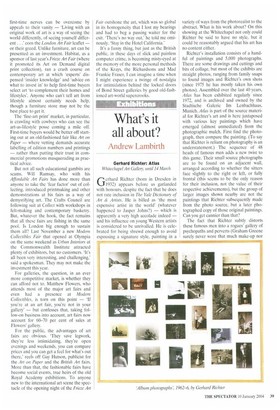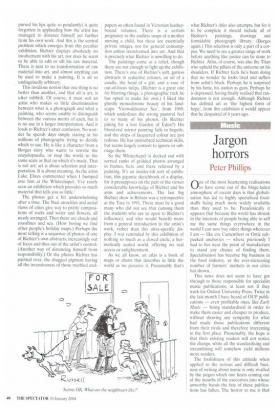What's it all about?
Andrew Lambirth
Gerhard Richter: Atlas Whitechapel Art Gallery, unti114 March
Gerhard Richter (born in Dresden in 1932) appears before us garlanded with honours, despite the fact that he does not rate inclusion in The Yale Dictionary of Art ek Artists. He is billed as 'the most expensive artist in the world' (whatever happened to Jasper Johns?) ŌĆö which is apparently a very high accolade indeed ŌĆö and his influence on young Western artists is considered to be unrivalled, He is celebrated for being shrewd enough to avoid espousing a signature style, painting in a
variety of ways from the photorealist to the abstract. What is his work about? On this showing at the Whitechapel not only could Richter be said to have no style, but it could be reasonably argued that his art has no content either.
Richter's installation consists of a handful of paintings and 5,000 photographs. There are some drawings and cuttings and bits of collage, but most of the exhibits are straight photos, ranging from family snaps to found images and Richter's own shots (since 1975 he has mostly taken his own photos). Assembled over the last 40 years, Atlas has been exhibited regularly since 1972, and is archived and owned by the Stadtische Galerie Im Lenbachhaus, Munich. Atlas is part of the source material for Richter's art and is here juxtaposed with various key paintings which have emerged (almost unmediated) from the photographic mulch. First find the photograph, then compare the painting. (To say that Richter is reliant on photography is an understatement.) The sequence of 48 heads of famous men adds a new twist to this game. Their small source photographs are to be found on an adjacent wall, arranged according to whether the sitters face slightly to the right or left, or fully frontal (this seems to be the only reason for their inclusion, not the value of their respective achievements), but the group of larger images shown nearby are not the paintings that Richter subsequently made from the photo source, but a later photographed copy of those original paintings. Can you get cannier than that?
The fact that Richter subtly distorts these famous men into a rogues' gallery of psychopaths and perverts (Graham Greene surely never wore that much make-up nor pursed his lips quite so petulantly) is quite forgotten in applauding how the artist has managed to distance himself yet further from his own work. And this is the central problem which emerges from this peculiar exhibition. Richter displays absolutely no involvement with his art, nor does he seem to be able to edit or sift his raw material. There is next to no transformation of raw material into art, and almost anything can be used to make a painting. It is all so undisguisedly arbitrary.
This insidious notion that one thing is no better than another, and that all is art, is utter rubbish. Of course, it must suit an artist who makes so little discrimination between what is a photograph and what a painting, who seems unable to distinguish between the various merits of each, but it is no use in a larger interpretation. And it leads to Richter's utter confusion. No wonder he spends days simply staring at his millions of photographs trying to decide which to use. He is like a character from a Borges story who wants to rewrite the encyclopaedia, or map the world to the same scale as that on which it's made. That is not art; art is about selection and interpretation. It is about meaning. As the artist Luke Elwes commented when I bumped into him at the Whitechapel: 'I've rarely seen an exhibition which provides so much material that tells you so little.'
The photos get a bit underwhelming after a time. The Nazi atrocities and aerial views of cities give way to pretty compositions of rocks and water and flowers, all neatly arranged. Then there are clouds and coastlines and sea. (How boring we find other people's holiday snaps.) Perhaps the most telling is a sequence of photos of one of Richter's own abstracts, increasingly out of focus and thus out of the artist's control. (Another way of distancing himself from responsibility.) Or the photos Richter has painted over, the dragged pigment having all the inventiveness of those marbled end
papers so often found in Victorian leatherbound volumes. There is a certain poignancy to the endless snaps of a mother nursing a child, but these are essentially private images, not for general consumption unless transformed into art. And that is precisely what Richter is unwilling to do.
The paintings come as a relief, though there are not enough to light up the exhibition. There's one of Richter's soft, gutless abstracts in seductive colours, an oil of a candle, the head of a girl, and a vase of out-of-focus tulips. (Richter is a great one for blurring things, a photographic trick he has opted to make his own.) I liked the ghostly monochrome beauty of his landscape Nierwaldstatter See', from 1969, which underlines the strong pastoral feel to so many of his photos. (Is Richter pining for a lost Garden of Eden?) His blood-red mirror painting fails to beguile, and the strips of lacquered colour are just tedious. He has undoubted technical skills, but seems largely content to ignore or sabotage them.
So the Whitechapel is decked out with serried ranks of gridded photos arranged in frames, here and there relieved by a painting. It's an insider-ish sort of exhibition, this gigantic sketchbook of a display, for it presupposes on the part of the viewer considerable knowledge of Richter and his aims and achievements. The last big Richter show in Britain was a retrospective at the Tate in 1991. There must be a good many who did not see that (among them the students who are so open to Richter's influence), and who would benefit more from a general introduction to the artist's work, rather than this ultra-specific display. I was reminded by this exhibition of nothing so much as a closed circle, a hermetically sealed world, offering no real access or enlightenment.
As we all know, an atlas is a book of maps or charts that describes in little the world as we perceive it. Presumably that's what Richter's Atlas also attempts, but for it to be complete it should include all of Richter's paintings, drawings and formidable photograph library. (Borges again.) This selection is only a part of a corpus. We need to see a greater range of work before anything like justice can be done to Richter. Atlas, of course, was also the Titan who upheld the pillars of the universe on his shoulders. If Richter feels he's been doing that no wonder he looks tired and suffers from artist's block. Perhaps he is surprised by his fame, his station as guru. Perhaps he is depressed, having finally realised that randomness is not enough. Although Richter has defined art as 'the highest form of hope', from this exhibition it would appear that he despaired of it years ago.



























































 Previous page
Previous page